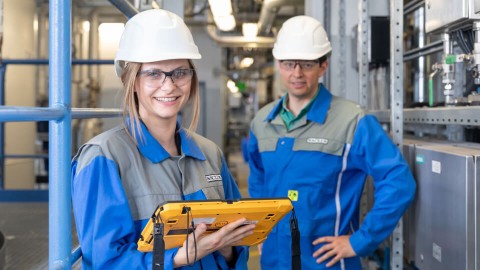VINNAPAS® EP 760

VINNAPAS® EP 760 is a unique, rapid-setting vinyl acetate-ethylene copolymer. It is not simply a high-solids version of VINNAPAS® EP series dispersion, but a polymer that has outstanding adhesion to very difficult-to-bond substrates including polyester, poly(ethylene terephthalate), tempered aluminum foil and polystyrene.
Properties
- Good adhesion to various plastic surfaces
- Permanently flexible adhesive joints
- High cohesion
Data sheets
Properties
VINNAPAS® EP 760 can be compounded in a manner similar to VINNAPAS® EP706 and accepts all the common plasticizers, solvents, tackifiers and fillers used with vinyl acetate ethylene dispersions. The dispersion combines very high-solids content with a low viscosity — a combination that permits the addition of very high filler loadings, resulting in adhesive formulations with solid contents as high as 80 percent, or even greater. VINNAPAS® EP 760 accepts extraordinary amounts of fillers, such as clay and calcium carbonate, without excessive thickening. It also does not thicken rapidly on the addition of plasticizers and solvents, which is a useful property where high solids at moderate viscosities are required. VINNAPAS® EP 760 is very shear stable, which means that it can be applied on high-speed packaging machines using roll, extrusion or spray equipment. The dispersion dries to a slightly tacky, clear, water-resistant film. It is compatible with other vinyl acetate-based polymers, including PVAc homopolymer, Acrylic lattices and VINNAPAS® copolymer dispersions.
Application
VINNAPAS® EP 760 high-solids content and excellent adhesion to plastic substrates make it especially useful in bonding PVC film to particle board, where the low water content reduces swelling of the wood. The excellent adhesion to difficult-to-bond surfaces shown by the dispersion is very useful in laminating films such as polyester, poly (ethylene terephthalate), poly (vinylidene chloride) and polystyrene to coated or uncoated papers. It shows good adhesion to metalized films and tempered aluminum foil. The rapid setting speed of VINNAPAS® EP 760 makes it very useful in high-speed packaging applications. The high-solids content is also important in bookbinding. The clear film and excellent adhesion of the dispersion are important in film overlay laminating. Typical application fields of VINNAPAS® EP 760 are as follows:
- Packaging (window cartons and carton forming)
- Envelop and bookbinding
- Textiles and upholstery
- PVC lamination and OPP wet lamination
- Packaging for difficult-to-bond substrates.
Packaging
- 200 Kg Steel drum
- 220 Kg Steel drum
- 1 MT IBC
- 1.1 MT IBC
- 1 MT Returnable tote
- Flexi bag.
- Tank lorry
Storage
When the dispersion is stored in tanks, proper storage conditions must be maintained. The product has a shelf life of 9 months starting from the date of manufacture if stored in the original, unopened containers at temperatures between 5 and 30°C. Any longer periods for the maximum storage period that may be described in the Certificate of Analysis which accompanies each shipment of the product, take preference over this suggestion in which case the time period stated in the Certificate of Analysis shall be solely authoritative. Iron or galvanized-iron equipment and containers are not recommended because the dispersion is slightly acidic. Corrosion may result in discoloration of the dispersion or its blends when further processed. Therefore, the use of containers and equipment made of ceramics, rubberized or enameled materials, appropriately finished stainless steel, or plastic (e.g. rigid PVC, polyethylene or polyester resin) is recommended. As polymer dispersions may tend to superficial film formation, skins or lumps may form during storage or transportation. Filtration is therefore recommended prior to utilization of the product.
Preservation for Transport, Storage and further Processing
The product is adequately preserved during transportation and storage if kept in the original, unopened containers. However, if it is transferred to storage tanks, the dispersion should be protected against microbial attack by adding a suitable preservative package. Measures should also be taken to ensure cleanliness of the tanks and pipes. In unstirred tanks, a layer of preservative-containing water should be sprayed onto the surface of the dispersion to prevent the formation of unwanted skin and possible attack by microorganisms. The thickness of this water layer should be < 5 mm for low viscosity dispersions and up to 10-20 mm for high viscosity products. Proper procedures - periodic tank cleaning and sanitization - must be set up in order to prevent microbial attack. Contact your biocide representative/supplier for further plant hygiene recommendations. Measures should be taken to ensure that only clean air enters the tank when the dispersion is removed. Finished products manufactured from polymer dispersions usually also require preservation. The type and scope of preservation will depend on the raw materials used and the anticipated sources of contamination. The compatibility with other components and the efficacy of the preservative should always be tested in the respective formulation. Preservative manufacturers will be able to advise you about the type and dosage of preservative required. If the product is stored for a longer period, stirring is recomended before use.
Sales and support
Allentown, PA 18106-9346
United States
+1 517 264-4088 (Fax)
How can we help you?
- Do you need help in choosing a product or do you require technical support? If so, please contact our experts.


